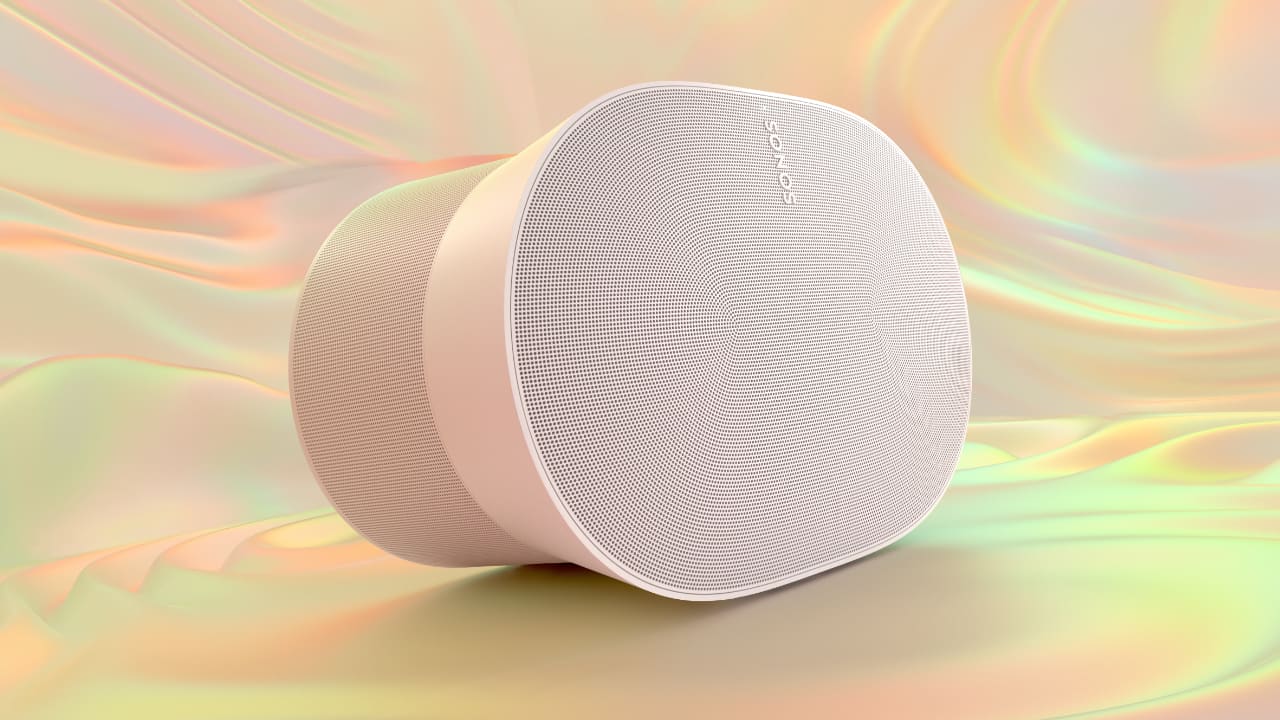
We don't usually review consumer products at RedShark, but the Sonos Era 300 is something different in audio technology and suggests a direction that audio might take in the future. And it's not just one direction, but every direction.
Sonos has always taken a different approach to how we should listen to audio in our homes. For the California-based consumer technology company, there's no reason we should tether our loudspeakers with cables and every reason to access our music choice in any room of the house. Over the last ten years, we've seen the rise of streaming services, smart speakers and online radio stations, and Sonos has adapted to stay relevant at the same time as CDs have done the opposite (with the notable exception of Vinyl, which we'll come back to later).
When I got my first Sonos speaker about four years ago, a small Sonos One, I was impressed with its sound - and its heft. Small speakers struggle with bass, but the One is a solid performer: it didn't shake the foundations, but for a diminutive, mono speaker, it coped well with a wide range of music. It proved a remarkably capable package with Alexa built-in and with Spotify as a music source.
Sonos has recently updated its small speaker range with the Era 100. From a distance, it looks like the One, but internally it's moved on and even has two tweeters for a sort-of stereo experience. So far, in Sonos terms, so conventional. But the Era 100's larger sibling, the $449 Sonos Era 300, is in a category all of its own because it is a spatial audio loudspeaker.
An unconventional shape
I don't have the language to describe the shape of it. Sonos describes it as a horizontal hourglass, but that doesn't quite cover it: it's more subtle than that. Once you get used to it, it's quite a pleasing shape. The reason for this oddness is that tightly packed inside are six audio drivers and multiple waveguides - and, I assume, a lot of digital signal processing. It all begins to make sense when you realise that the primary goal of this loudspeaker is to produce a multi-directional sound.
There's something quite Apple-like in Sonos' design and packaging. That's true of a lot of products these days, but it's certainly impressive. Nothing about this expensive single speaker suggests it's not worth the money.
And luckily, when you turn it on and listen to it, it gives the same impression. I was expecting it to be good, but I didn't expect it to blow my socks off.
So, after that rather unscientific initial appraisal, here are my impressions in more detail.
The Era 300 in detail

I already knew that Sonos speakers can totally belie their size. They're typically louder and deeper than you'd expect if you've not tried them before. And the Era 300 was no different, except that it was even louder and even deeper than I would have thought possible. There is some serious engineering inside this thing.
Of course, I tried a variety of tracks. In stereo, any spatial effect is marginal. You won't be impressed by the width of the stereo image: it is, after all, a single unit for all its multi-directional speaker drivers. But it also rarely sounds like a point source. Close your eyes, and while you can easily sense the music centred in a single location, it feels more like a cloud than a single source. It's hard to describe, but whatever it is - and it will be different for each listener and each room, and each position in each room - it is a perfectly pleasant experience. The sound is full-bodied, taut and controlled but never overly constrained. The bass is seemingly bottomless - you don't need an additional subwoofer for music with this speaker - and the mid-range is detailed. The high-end could be crisper, but it's smooth and never brittle. Overall, the balance is very good. It does, though, seem to vary a lot between different types of music. That's not a negative reflection on the speaker, though.
The simple fact is that recorded music itself varies a lot between tracks. Not only that, but how it's delivered is a significant factor too.
The Era 300 is a wireless speaker. It has a lot of I/O options, although, frustratingly, it doesn't have an optical digital one. That means you can't use it as a Dolby Atmos speaker for a TV with a direct optical connection. But it has Bluetooth and WiFi, and, via an optional Audio to USB C adaptor, a line in. That means you can connect (via a pre-amplifier) a record deck. There's a huge irony here if anyone feels they should do that because you could hardly get a more digital system than the insides of this loudspeaker! But having a line-in ticks an essential box for some users.
Bluetooth will always be a limiting factor for audio quality until it's fast enough for multi-channel uncompressed audio, but today's Bluetooth differs from the early versions. I have an Apple Airpods Max - an over-the-ear headphone that only works over Bluetooth - and I'm impressed.
I've never felt Bluetooth was a massive drawback, but if you're obsessive about getting the ultimate quality, you'd probably want an uncompressed connection. Where Bluetooth shines, though, is that it makes it so easy to connect, say, a phone to a speaker. Let's say you have friends round, and they want to try their favourite tracks on your Era 300. There's a hardware Bluetooth button on the speaker that allows them to connect in seconds.
You will find a very noticeable difference in quality between high-bitrate streaming services and, say, a commercial pop radio station. In the UK, Greatest Hits radio sounded dull and (dynamic range) compressed. This may have been because of its bitrate, but I suspect it's also because of loudness management by the station, where broadcasters try to make the music sound as loud as possible at the expense of dynamic range. Some tracks, streamed from Apple Music, like Cloud Nine by Ms Dynamite & Shy FX, have some delicious sine wave-type sub-bass that you won't hear on laptop speakers but which goes right through you played on the Era 300. Appalachian Spring by Aaron Copeland has a spectacular dynamic range, and the Sonos handled it expertly.
Spatial, the final frontier
So far, so impressive, but here's where it all starts to get a bit weird, but in a very good way. That's because the whole purpose of the Era 300 is to give you spatial audio from a single, for want of a much better word, box.
To see how it does this, you need to understand that merely putting six loudspeakers in a cabinet and pointing them in different directions won't give you much of a spatial audio experience. There's a secret sauce at work here, and that's in the software. For a long time, audio technology companies have researched how to give you a spatial experience from a smaller-than-ideal number of speakers. It turns out that with subtle processing and the clever stuff behind Dolby Atmos encoding, you can unpack detailed spatial cues. I suspect that there's even more to it than this because Dolby Atmos assumes physical speakers front and rear and even above.
In a sense, the Era 300 tries to be a virtual Atmos setup. And to some extent, it succeeds. Why only to some extent? Because you can't escape the fact that it's not as good as having discrete loudspeakers. If the music mix calls for a speaker behind you, the Era 300 can't do that because it isn't behind you. But it certainly has a good try at convincing you that "behind you" sound isn't coming directly from the box.
As with "conventional" stereo music, you get a lot of variability between Atmos tracks, and, again, you'd expect that. If you're listening to an Atmos mix of a solo acoustic guitar, you don't want guitars to the side, above and behind you. Instead, you might want a hint of the concert hall's acoustics where the recording took place. For electronic dance music, there are no rules, and you can expect all kinds of spatial effects.
I found I was frustrated by a few things with spatial audio. First, finding the tracks in the first place takes a lot of work. None of the streaming platforms let you search for them specifically, and you can't search from within Sonos's app, either. I'm pretty sure this will change as the format becomes more established. And getting Atmos tracks to play at all on the Sonos can be tricky because you can't use Apple Airplay for Dolby Atmos (I would expect Apple to update this in the near future). Your best bet is to subscribe to Apple Music, add the service to the Sonos App, and play the music from there. If you don't tick all these boxes (and I didn't at first, which was frustrating), then you won't hear spatial audio from the Era 300.
That's not a deep criticism. These are early days for consumers with spatial audio - as it is for music producers. It's not massively established as a format, and I would confer kudos on Sonos for being so bold as to bring this speaker to market.
A winner, spatial or no spatial
But while that might make the Era 300 seem like an extremely niche device, it's not really, because with or without spatial audio, it is the best wireless speaker I have heard. For now, it is a stunningly capable speaker for conventionally mixed music, and you can expect that in a year or so, it will be much easier to get hold of and play Dolby Atmos mixes. There's a lot of software inside the Era 300, and I suspect we'll see updates bringing new features and refining existing ones.
Sonos' branding of this spatial audio speaker is spot-on. It is a new era. This thing is incredibly impressive.
In a way, it sounds like a philosophical category mistake: how can a single loudspeaker surround anything? It can't, but that doesn't stop it from trying very hard and, sometimes, very nearly succeeding. The question is, is it an experience worth the hefty $449 / £449 price tag? Like the Era 300 itself, the answer is nuanced, but I think it's "yes".
Tags: Audio


Comments